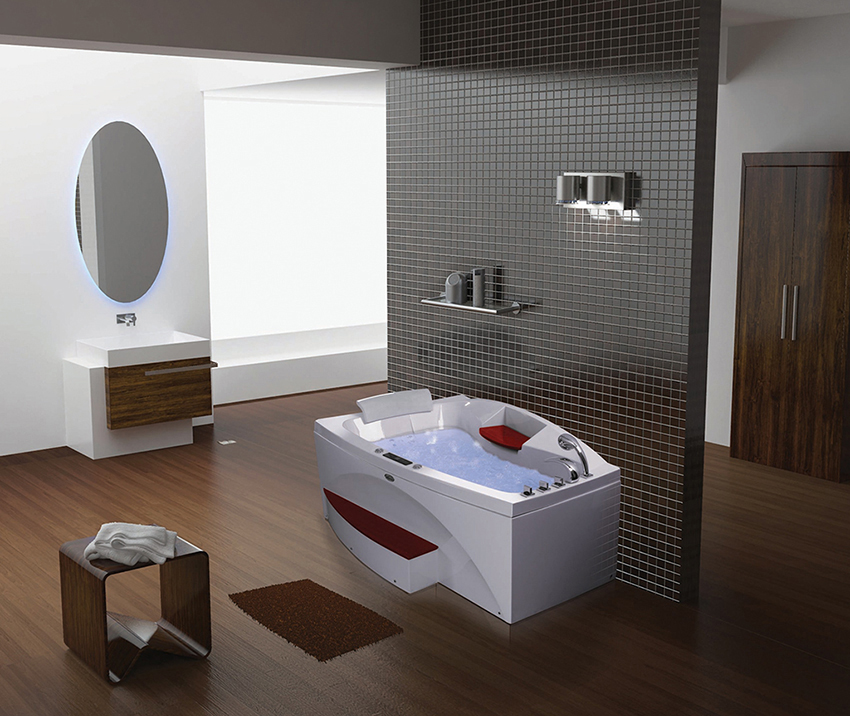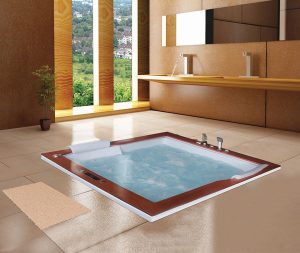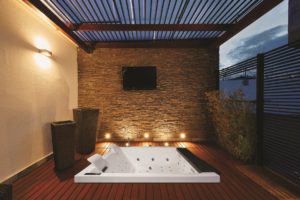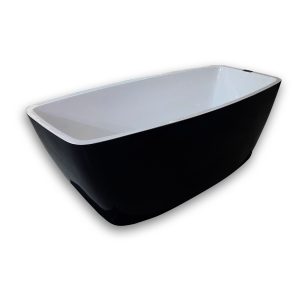When it comes to designing your dream bathroom sanctuary, the bathtub often serves as a central focus that sets the relaxing vibe for the whole space. You likely picture yourself unwinding in a nice, long soak after a stressful day. But what type of tub should you choose to pull your spa-like vision together – the classic rectangular built-in style or a elegantly curved freestanding version?
Both options have their pros and cons when considering critical factors like the overall design, functionality, size, ease of access, and aesthetic appeal. The right selection for your home really depends on your bathroom’s layout and dimensions along with your personal needs and style preferences. Here’s an in-depth comparison overview of rectangular and freestanding tubs to help make your decision easier.
The Standard Built-In Rectangular Bathtub
Close your eyes and picture a classic bathtub – chances are you envision the standard rectangular variety nestled into a corner or alcove area. This is likely similar to what you grew up using for everything from a quick shower to relaxing Sunday afternoon bubble baths. The simple built-in design features access from three sides and fits snugly into smaller or larger bathrooms.
Design & Functionality Perks
Since it connects directly to the surrounding walls, you can find rectangular bathtubs available in a wide variety of lengths and depths to work in big or little spaces. The most common setup places it combined with an overhead shower, creating an efficient and compact bathing area. The basic tub shape and classic style blends in beautifully with almost any bathroom layout.
Some homeowners opt for a corner tub variation that tucks neatly into two walls, opening up additional floor space. You can also choose models with one contoured end for a bit more comfort and support. If adding a handheld or rain shower head overhead, be sure to choose a tub deck that can accommodate the necessary plumbing.
While perhaps not as visually showy as a freestanding tub, the humble rectangular built-in remains a tried and true practical choice suitable for spaces of all sizes. You can even add an elegant touch by installing lovely decorative tiling around the tub area.
The Attention-Grabbing Freestanding Tub
On the other end of the spectrum, a freestanding bathtub serves as an impressive stand-alone focal point that commands attention. It brings instant elegance and wow-factor into a bathroom space. Unlike its built-in counterpart, by design this tub style cannot connect to any walls. It needs open areas around all or at least most sides.
Since they don’t neatly tuck into a corner, freestanding tubs work best in larger, open bathroom floor plans. This makes the striking tub area seem like the centerpiece of a spa treatment room. The open and elegantly curved shape provides an inviting and luxurious look compared to the basic straight-lined rectangle. Just picture yourself unwinding in the sloped comfort of its inner sanctuary – very serene and peaceful!
Special Design Factors to Consider
However, going the freestanding route does come with a few special installation considerations. For starters, you need ample space around the tub to access it comfortably. All sides require some open floor area. Freestanding tubs also demand proper planning for linking the drainage to the home’s plumbing system.
Since they don’t connect directly into wall framing, a seasoned contractor can advise on any potential floor support modifications needed to handle the weight. The drain set-up remains a key factor in placement within the bathroom. And unlike a built-in with three access sides, you only have one or perhaps two sides to enter a freestanding soak.
But once in place, it makes a gorgeous high-end style statement! For a truly top-notch spa vibe, add coordinating plush towels, flickering candles, and a tray table for holding a nice glass of wine or cup of tea. Tranquil bathing at its finest!
Aesthetic Appeal & Design Options Galore
Both rectangular and freestanding tubs now come available in a wide range of durable materials – from classic porcelain, stone resin, acrylic to exotic bronzed woods, sparkling quartz blends, and stainless steel. More budget-friendly options include fiberglass and enameled steel. Each material boasts its own visual appeal, feel, and needs for care and cleaning.
And when it comes to color or finish, the sky’s the limit! For contemporary trend lovers, sleek glistening whites remain top choice. But you also can select glossy or matte hues in soothing neutrals like creamy bisque and warm sand tones to bold jet black. Many freestanding tubs feature a high-gloss gelcoat lacquer that resists fading and scratches over years of blissful bathing.
Be sure to pick tub fixtures, tiles, accents, and hardware that coordinate beautifully with your chosen finish. A common design approach plays up bold contrasts, like pairing an icy white tub against rich chocolate walls or vice versa. Or create a super sleek monochromatic look choosing all elements in muted shiny charcoal. The options await your inner designer!
Choosing Bathroom Fixtures with Cohesive Styling
Most bath designers advise choosing plumbing elements like the sink, toilet, hardware and lighting that somehow tie into the style of your bathtub selection. For contemporary edge, linear rectangular bath fixtures work nicely with a rectangular soaking tub. The elegance of a curved freestanding tub finds an ideal match with similar contoured sinks, tankless toilets, and polished chrome or bronze accents.
If your personal taste leans modern minimalist, keep all fixtures sleek and simple without overly ornate detailing. For a more vintage cottage charm, add vintage-style fittings, solid wood storage cabinets, shuttered windows, and a touch of lace curtain. Develop an overall cohesive look pulling the whole room together visually. Mixing too many contrasting styles generally detracts from that serene spa ambiance.
Determine Ideal Tub Size
Tub size definitely matters for comfortably soaking those weary muscles after an exhausting day! While a small 25-inch deep rectangular tub may work fine for quick showers, you’ll want more generous proportions for serious relaxation. Measure across your shoulders to determine ideal tub width – minimum of 22 inches allows room to stretch out. Pro bath experts suggest at least a 30-inch depth for legs and knees to dip fully underwater.
For soakers over 5’8″, corner tubs provide needed length to recline head-to-toe diagonally. And simple budget-friendly tub expanders now allow adjusting regular tubs out an extra few inches on each end. Some oversized models span an impressive 72 inches corner-to-corner. Just be sure to have reinforcements added below to properly support all that splashing weight!
Bathroom Layout Logistics
Available space ultimately plays a starring role in choosing between a built-in rectangular or attention-grabbing freestanding tub design. Measure your current bathroom footprint carefully, allowing for other essential components like the toilet, sink vanities, and shower/tub surround. Create a scale drawing mapped out with accurate dimensions noted.
If you have limited square footage, the classic rectangular tub fitting snuggly into a corner frees up valuable floor area. Small alcove installations also minimize the foot space needed. Just confirm measurements allow adequate clearance between tub edge and the toilet or doorway routes.
For those renovating an older or awkwardly laid out bathroom, consider creative options like curved outward facing tubs placed on a diagonal that make smart use of unused pockets of space. This allows some flexibility while working within restrictive dimensions.
Homeowners blessed with a more spacious bath sanctuary will find plenty of layout leeway for installing a glamorous freestanding tub in a choice spot. But be sure to account for the extra floor clearance required around all sides – most building codes mandate at least 21-24 inches. Carefully plot out potential placements, factoring in ceiling heights that prevent tall tub styles from bumping up too closely.
Also assess if bathroom door locations will accommodate a large curvy tub model needing to be maneuvered into the ideal position. Nothing ruins your perfect placement like realizing the prized new tub won’t actually fit through the entry route once fully assembled onsite! If current doorway access seems iffy, call in an experienced bath contractor early on to evaluate.
Identify Your Personal Bathing Needs & Style
Beyond basic size and layout restrictions, take time to reflect on how your family plans to use the bathtub most. Is it mainly for a quick morning wake-up shower or more for leisurely Saturday night bubble baths with candles and wine? Do you hope to relax in peaceful solitude or require room for bathing active kiddos? Will it get used multiple times per day or just occasionally?
These usage considerations help steer you towards either pragmatic rectangular built-in tubs or indulgent freestanding styles. Make lists of must-have features like massaging jets, temperature-regulating heaters, or even waterproof Bluetooth speakers for musical motivation! Prioritize which elements matter most – purely practical or more pampering luxury touches.
In Summary…
Ultimately both classic rectangular built-in tubs and elegant freestanding styles enhance bathroom spaces with comfort and versatility. More modest alcove installations suit family functionality while stand-alone models create a relaxing spa focal point.
Hopefully the detailed compare and contrast info above provides helpful guidance on narrowing down what best fits your home layout, budget, functionality necessities and style goals. Just remember – no universally “perfect” tub exists! Choose what brings you joy and happiness.




